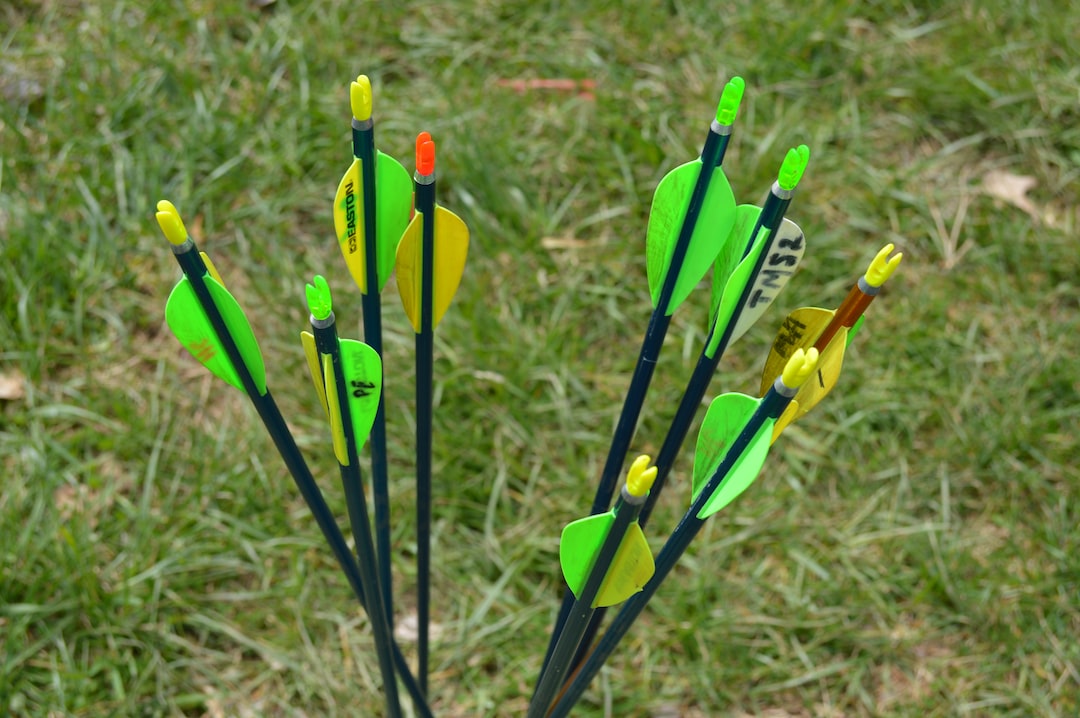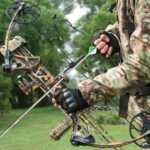When it comes to hunting, having the right gear is essential. And one of the most important pieces of equipment you need are your arrows.
But how do you choose which ones are best for hunting?
From building your own arrows to choosing pre-made options or even understanding field tips vs broadheads, there’s a lot that goes into picking out the best hunting arrows.
We’ll take a look at all these factors and more in this blog post so you can be sure that when it comes time to go on your next hunt, you have just what you need – the best hunting arrows possible.
Choosing the Right Arrow for Hunting
Arrow Length:
When selecting arrows for hunting, the length of the arrow is an important factor to consider. The ideal arrow length should be based on your draw length and bow type.
If you have a longer draw length, then you may need a longer arrow to achieve optimal accuracy and power.
Conversely, if you have a shorter draw length, then you may need a shorter arrow in order to maximize performance. It’s best to consult with an archery professional or use an online calculator when determining the right size for your setup.
Arrow Weight:
Arrow weight is another key factor that affects accuracy and power when shooting arrows for hunting purposes.
Generally speaking, heavier arrows are more stable in flight than lighter ones; however, they also require more energy from the bow to reach their maximum speed potential at launch.
Lighter arrows can provide faster speeds but can be less accurate due to their lack of stability in flight. As such, it’s important to find the right balance between weight and speed when choosing arrows for hunting applications.
Arrow Spine:
The spine of an arrow refers to its stiffness or flexibility along its shaft; this will affect how much it bends upon release from the bowstring as well as how quickly it recovers after being shot through air resistance during flight towards its target destination point (i.e., game animal).
A stiffer spine will result in less flexing while shooting which can lead to improved accuracy; however too stiff of a spine could cause excessive vibration upon impact with game animals resulting in poor penetration rates so finding just the right amount of stiffness is key here.
Fletchings are small feathers or vanes attached near one end of an arrow shaft that help to stabilize its trajectory during flight by providing drag against air resistance, similar to wings on airplanes.
Different types and colors of fletching offer different levels of drag which can affect overall accuracy; bright colors tend to work better outdoors while duller colors may be more suitable for indoor shooting where lighting conditions are not ideal. It is important to find the right combination that works best with your particular setup in order to maximize accuracy.
Nocks are plastic pieces attached near one end of an arrow shaft that allow them to securely attach onto string loops found on bows.
There are two main types: flat nocks which fit over flat surfaces found at most recurve bows, and capture nocks which snap into place via grooves located inside compound bows making them easier and quicker to install and remove compared to flat nocks.
Therefore, make sure you choose the appropriate type based off what kind of bow you own.
The right arrow for hunting is a personal choice, and there are many factors to consider. With careful consideration of the type, length, weight, spine, fletching type and color, and nock type that best suits your needs; you can ensure that you have chosen the perfect arrow for your next hunt.
Now let’s move on to building our own arrows.
Building Your Own Arrows for Hunting
Building your own arrows can be a great way to ensure you have exactly what you need for any hunt. Here are some tips on how to build your own arrows for hunting:
Selecting the Right Shafts:
The first step in building your own arrows is selecting the right shafts. You’ll want to choose shafts that are strong and lightweight so they won’t slow down or weigh down your arrow when fired from a bow.
Carbon fiber and aluminum are popular choices for hunting arrow shafts as they offer both strength and lightness without sacrificing durability.
Preparing the Shafts for Fletching and Inserts:
Once you’ve selected the right shafts, it’s time to prepare them for fletching and inserts. This involves cleaning off any dirt or debris from the surface of each shaft with a soft cloth before applying adhesive tape along its length where fletchings will be attached later on.
Additionally, if using inserts such as nocks or points, make sure there is enough space between them so that they don’t interfere with one another when installed onto an arrow’s end-grain wood core (if applicable).
Installing Fletchings and Inserts:
After preparing each arrow’s surface area, it’s time to install fletchings and inserts into place.
For this step, use an appropriate glue designed specifically for attaching feathers or plastic vanes onto carbon fiber or aluminum shafting material – depending on which type of material was used during selection earlier on in this process.
Additionally, take care not to apply too much pressure while installing these components as doing so could cause damage due to excessive force being applied directly onto delicate parts like feather vanes.
Lastly; once everything has been securely glued into place allow ample drying time before moving forward with cutting each individual arrow down in size according their desired lengths (as discussed next).
Now that all components have been properly secured into place via gluing, it is time to cut each individual arrow down to their desired lengths. Before beginning, make sure that all measurements taken during this stage are accurate by double checking against previously recorded data such as draw length and weight.
Furthermore, always use sharp scissors made specifically for cutting through materials like carbon fiber and aluminum when trimming away excess portions of either type of material respectively.
Finally, after ensuring accuracy throughout this entire process, simply repeat steps 1 through 4 until every single one of your newly built custom hunting arrows has been completed successfully.
By building your own arrows, you can customize them to fit your individual needs and preferences. However, pre-made arrows may be more convenient for those who are short on time or don’t want the hassle of making their own. Let’s explore the pros and cons of pre-made arrows for hunting next.
Pre-Made Arrows for Hunting
Pre-made arrows are a great option for hunters who don’t have the time or skills to build their own.
Pre-made arrows come in a variety of styles and materials, so it’s important to choose the right one for your needs. Here we will discuss the pros and cons of pre-made arrows, types available, and how to select the right one for you.
Pros and Cons of Pre-Made Arrows:
Pre-made arrows offer convenience as they require no assembly or preparation before use. They also tend to be more accurate than homemade arrows due to consistent spine ratings across all shafts in a set.
On the downside, pre-made arrows can be expensive compared to building your own, and they may not fit everyone’s individual needs perfectly.
Pre-made arrow shafts come in a variety of materials, each offering its own advantages depending on the type of hunting you plan to do.
Carbon fiber is lightweight yet stiff; aluminum alloy provides good durability without sacrificing accuracy; wood/fiberglass composites offer an excellent balance between weight and strength; bamboo/wood composites provide superior flexibility while still being strong enough for most applications; and solid wooden shafts with feather fletching give traditional looks that many hunters prefer when out in nature.
When it comes to pre-made arrows for hunting, there are many pros and cons that should be considered. Once you have decided on the right arrow for your needs, you will need to determine which type of tip is best suited for your hunt – field tips or broadheads.
Field Tips vs Broadheads
Field tips and broadheads are two of the most popular arrowhead types used for hunting. You need one to train with the other.
Each type has its own advantages and drawbacks, so it’s important to understand which one is best suited for your specific needs.
Advantages of Field Tips:
Field tips are designed primarily for target practice or small game hunting. They provide a more accurate shot due to their larger surface area, allowing them to penetrate deeper into the target than a broadhead would.
Additionally, they don’t require as much force behind them in order to be effective since they have less cutting power than a broadhead does. This makes field tips ideal for those who want accuracy without sacrificing too much power.
Advantages of Broadheads:
Broadheads are designed specifically for big game hunting and offer more stopping power than field tips do due to their sharp blades that can cut through thick hide and bone with ease.
Mechanical broadheads also tend to fly straighter than field points because of their aerodynamic design, making them great choices when shooting at longer distances or windy conditions where accuracy is key.
When choosing between field tips and broadheads, it is important to consider the advantages of each type and select the one that best suits your hunting needs. For those looking for a lighter arrow with improved penetration capabilities, micro-diameter arrows may be worth exploring as an alternative option.
Micro-Diameter Arrows
Micro-diameter arrows are becoming increasingly popular among hunters, as they offer a number of advantages over traditional arrows. These lightweight and durable shafts can provide improved accuracy and penetration, while also allowing for greater arrow speed. But before you make the switch to micro-diameter arrows, it’s important to understand their benefits and drawbacks.
Benefits of Micro-Diameter Arrows:
The primary benefit of using micro-diameter arrows is that they are significantly lighter than traditional shafts. This means that they require less energy to propel them forward at higher speeds, resulting in increased accuracy and penetration power on impact.
Additionally, these types of arrows typically have a smaller diameter than standard ones which allows them to be more aerodynamic when fired from a bow or crossbow – resulting in even better accuracy.
Finally, due to their light weight construction these type of shafts tend to last longer than heavier counterparts since there is less stress placed on the components during flight.
Despite the numerous advantages associated with using micro-diameter arrows for hunting, there are some potential drawbacks to consider. Due to their light weight construction, these type of shafts may not penetrate deep enough into an animal if shot from too far away; this could be a problem for hunters who prefer long range shots or those who hunt large game animals such as elk or moose where deeper penetration is necessary.
Additionally, due to their small size these type of arrowheads may not be able to handle larger broadhead designs which could limit your options when selecting tips for your setup depending on what kind of game you plan on pursuing with your bow or crossbow setup.
When selecting a micro-diameter arrow, it is important to ensure that it matches the draw length and draw weight specifications set by your bow or crossbow model. This will help prevent any potential damage to yourself or your equipment during use.
Additionally, you should consider how much kinetic energy each arrow has upon release in order to determine its effectiveness based on distance from target; closer targets require less kinetic energy.
Lastly, make sure that whatever design/style tip(s) you choose fits properly onto the end(s) of your chosen arrow shaft(s).
FAQs in Relation to Best Hunting Arrows
What type of arrow is best for hunting?
The best type of arrow for hunting depends on the game you are hunting, the terrain and conditions, and your own personal preferences. Generally speaking, carbon arrows offer superior strength and accuracy compared to aluminum or fiberglass arrows. They also tend to be lighter in weight which can help with long-distance shots.
For big game such as deer or elk, heavier arrows with larger diameter shafts are recommended for increased penetration power. Finally, it’s important to select an arrow that is properly matched to your bow draw weight so that you get maximum performance from your equipment.
With all these factors taken into consideration, there is no single “best” type of arrow – only the one that works best for you, whether you are an expert or just starting out.
What arrows do pro hunters use?
Professional hunters typically use arrows made from carbon, aluminum, or a combination of both materials.
Carbon arrows are known for their superior strength and durability while aluminum arrows offer a lighter weight option with good accuracy.
The type of arrow chosen depends on the hunting style and preferences of the individual hunter. For example, some prefer heavier-weighted arrows for longer distances while others may opt for lighter-weight options to increase speed and maneuverability in tight spaces.
Ultimately, it is up to each hunter to decide which type of arrow best suits their needs.
Is a 400 grain arrow good for deer?
Yes, a 400 grain arrow is an excellent choice for deer hunting. The heavier weight of the arrow ensures that it has enough kinetic energy to penetrate deep into the animal and cause a quick kill.
Additionally, its aerodynamic shape allows it to fly further and straighter than lighter arrows, increasing accuracy at longer distances. When paired with a quality broadhead, this combination can be lethal on even the largest game animals.
What is the best arrow for accuracy?
When it comes to accuracy, the best arrow for hunting is one that has been carefully crafted and designed with precision. A high-quality carbon fiber or aluminum shaft will provide a straight and consistent flight path, while a heavier grain weight will ensure maximum kinetic energy transfer upon impact.
Additionally, the fletching should be tailored to your bow setup in order to reduce drag and improve stability in flight.
Finally, make sure you choose an arrow with a properly sized insert for optimal fitment on your bowstring. With these factors considered, you can rest assured that your arrows will fly true every time.
Conclusion
Whether you choose to build your own arrows or buy pre-made ones, selecting the right arrow weight and fletching color can make a huge difference in accuracy and power.
Make sure you have a good release, and that your bow is properly setup and tuned. Always have a practice target on-hand so you can get those practice reps in.
Additionally, understanding the differences between field tips and broadheads as well as micro-diameter arrows will help you find the best hunting arrows for your needs. With all of these factors taken into consideration, you’ll be sure to have an enjoyable hunt with great results.



